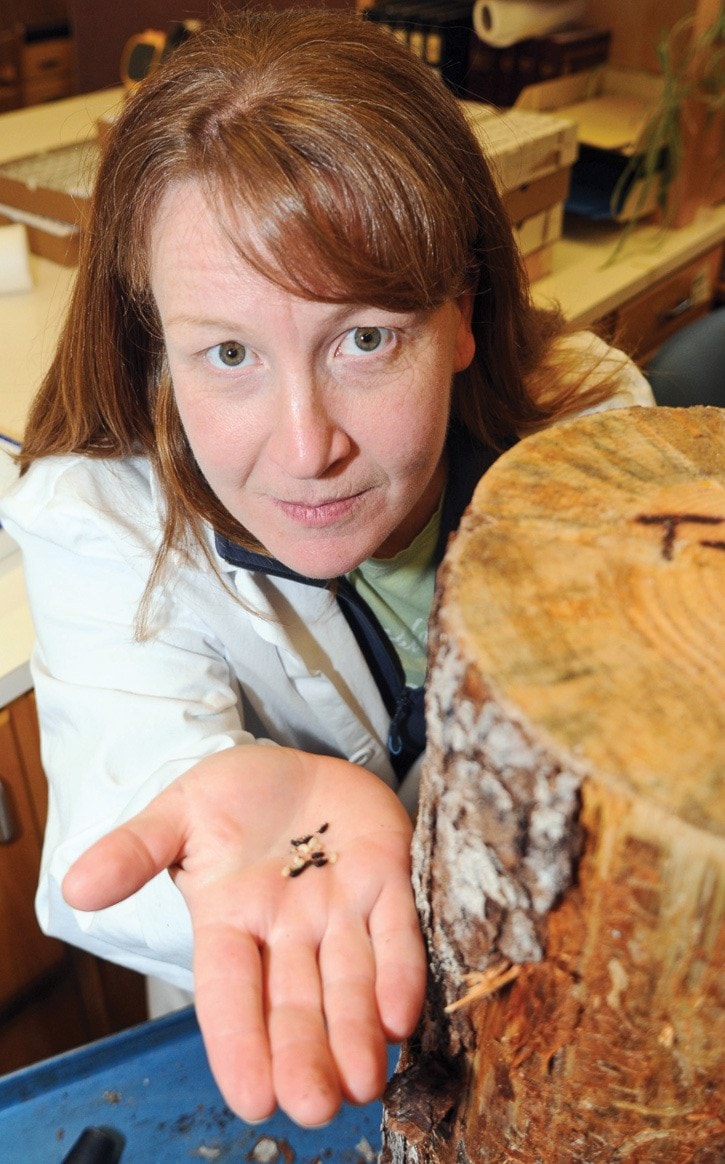The B.C. government doesn’t have enough information about its forest management to deal with the long-term results of widespread beetle kill and fires, B.C. Auditor General John Doyle concludes in a report released Feb. 16.
Doyle’s report also criticizes the province’s shift of responsibility for replanting logged Crown land from the ministry to logging companies.
Since 2004, logging companies have been responsible for replacement trees until they reach “free growing” height, which takes seven to 20 years depending on species. The audit found the policy tends to reduce species diversity.
“Reforestation is a cost to forest companies, not an investment,” Doyle writes. “In managing their business, forest companies tend to take the least-cost, least-risk approach to meet reforestation regulations, which means planting lower-cost, faster-growing species.”
Doyle also concluded that the forests ministry has fallen behind in a long-standing commitment to reforest areas damaged by natural disturbances before 1987, when industry first became responsible for replacing harvested areas.
Opposition MLAs pressed Forests Minister Steve Thomson in the legislature Thursday.
“The ministry is degrading the forest,” said NDP forests critic Norm Macdonald.
Thomson replied that the government has invested $236 million in its Forests for Tomorrow program since 2005, when it was set up in response to the pine beetle epidemic in the B.C. Interior. That program calls for 14.5 million seedlings to be planted in 2012-13 and another 21.5 million in 2013-14.
While Doyle called for immediate action and a follow up of his report in April, the full impact of the pine beetle’s spread into new habitat outside B.C. may not be seen until decades down the road, said Kathy Bleiker, a research scientist based out of the Pacific Forestry Centre in Saanich.
Bleiker measures the developmental rate, survival and reproductive success of the beetle’s immigration east during extended field studies in Grande Prairie, Alta.
The pine beetles are now attacking Alberta’s jack pine and continue to chart new territory in Alberta. The insects have been recorded nearly as far east as Fort McMurray, just shy of the Saskatchewan border.
“It’s sort of hard to predict what’s going to happen right now in Canada’s boreal forests,” Bleiker said. “More of the research is focused on spread in the forest and ways to slow it. We may not see huge population explosions in Alberta, but I think it’s there to stay where it wasn’t before.”
Speaking to reporters, Thomson, the forests minister, rejected the Auditor General’s conclusion that the ministry is falling behind in reforestation. But he acknowledged that the current estimate of 733,000 hectares “not satisfactorily restocked” is likely to be revised upward once an ongoing update of B.C. forest inventory is complete.
The ministry’s estimate of potential area suitable for replanting due to pine beetle destruction is 650,000 hectares.
“We’re working through the harvesting of the mountain pine beetle,” Thomson said. “What we have to do is make sure that we know where areas are being harvested or not harvested before we go in and do the reforestation work, because we don’t want to put resources into areas that still need to be available for potential salvage harvesting.”
Understanding the spread
Warmer winters failed to kill beetle larvae and summer droughts stressed host trees.
The two main contributing factors in the pine beetle epidemic also came at a time when an increased presence of the beetle’s preferred host, mature pine, was plentiful. The conditions were set for a mountain pine beetle population explosion.
“The more beetles there are, the healthier and healthier the trees they can overcome,” Bleiker said. “It’s positive feedback and that’s why you can get runaway growth.”
Researchers believe that when the destruction began there was three times more mature pine on the landscape in B.C. than there was 100 years ago, possibly due to improved fire suppression over the last century.
Strong winds then pushed beetles some 400 kilometres over the Continental Divide, where they have survived for several years now.
“We might not see immediate population explosions in Alberta right now, or in the next 10 years, but I think they’re there to stay,” Bleiker said, noting the added challenge of foreseeing impacts during a time of climate change. “In 20 or 30 years if conditions are favourable and the weather is favourable and the climate’s favourable and there are host trees – you could have a problem.
“I’m almost a little worried that if (beetle) populations fall too low now and they fall off our radar, in 30 years, someone else is going to have a big problem.”
nnorth@saanichnews.com
- with files from Tom Fletcher
Pine beetle facts:
• Measure about 5 millimetres in length.
• Are native to western North American forests and play a role in the natural development of forests, weeding out weak trees.
• Have caused less damaging forest disturbances, including in the early 1980s.
• The current beetle outbreak began in the early 1990s and is still outbreaking in the southeastern and northeastern regions of B.C., especially the Peace Region.
• The beetles have destroyed 726 million cubic metres, or 18.5 million interior logging trucks of timber during the current outbreak.
• One female beetle can lay as many as 60 eggs.
• Beetles can survive on most any species of pine, but do the best on lodgepole pine, the most common form of pine in B.C. When the beetles are intensely outbreaking in a stand, they may attack another species of tree, such as spruce, but they won’t continue on once the surrounding pine has been killed.
Related: Saanich home to experts on pine beetle blight
